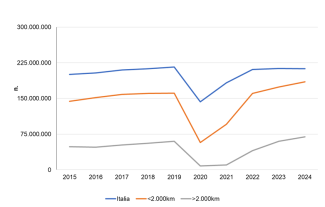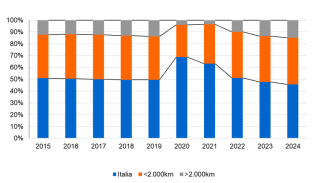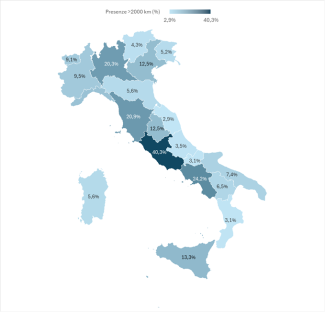Panel 1
Giovanni Finocchiaro, Silvia Iaccarino
The indicator measures the dependence of Italian tourism on international markets, particularly those farther away, by assessing the environmental impact associated with long-distance transportation. In 2024, total stays reach 466.2 million, with 14.8% coming from countries located more than 2,000 km away. This share, which has grown compared to 2023, confirms the recovery of international flows and a return to pre-pandemic levels. However, it also represents a critical issue for the environmental sustainability of the sector, as long-haul air travel significantly contributes to CO2 emissions.
This indicator is part of the environmental dimension of the European Union Tourism Dashboard and measures Italy’s dependence on long-distance international markets.
Countries of origin are considered distant if they are located 2,000 km or more from the destination.
A high indicator value implies a potentially greater environmental footprint due to long-haul travel emissions.
To assess this, the number of overnight stays in accommodation facilities (tourist presences) from long-distance visitors is analyzed, as their travel impacts both infrastructure and CO2 emissions.
To illustrate the potential environmental impact caused by tourism from long-distance international markets.
The indicator does not respond to specific regulatory references.
Panel 2
https://tourism-dashboard. ec. europa. eu
Data quality assessment
Istat (National Statistics Institute)
http://dati. istat. it/ "Customer movement in receptive exercises - annual data" - country of origin.
National, regional
2015-2024
Indicator assessment
The indicator is calculated based on the number of overnight stays in accommodation facilities (tourist presences) by foreign tourists from distant origins.
Countries are considered distant if at least 50% of their territory is located 2,000 km or more from Italy's geographical center. Additionally, the overnight stays of tourists from closer distances (<2,000 km) and domestic tourists are also recorded.
In 2024, total attendance in Italy reaches 466.2 million, marking an increase compared to 2023. Tourists from foreign countries amount to approximately 253.9 million, of which 184.9 million come from distances less than 2,000 km, and 69.1 million from greater distances. The share of tourists from distant countries thus stands at 14.8% of the total (Table 1, Figure 2).
These long-haul trips, predominantly made by air, significantly contribute to the increase in greenhouse gas emissions and the overall environmental impact of the tourism sector. While domestic tourism and visitors from closer countries contribute less to emissions from transportation, the reliance on tourists traveling from far distances indicates a higher ecological footprint. Overall, the state can be considered moderate, as the growth of distant markets is economically positive but increases the environmental pressure linked to long-distance transportation. From an environmental perspective, progress is not heading in the desired direction. The current challenge is to find a balance between welcoming tourists from distant markets and the need to limit environmental impact, promoting more sustainable travel methods.
Between 2015 and 2019, the share of tourists from distant countries increased from 12.4% to 13.7% (Table 1, Figure 1). Following the collapse in 2020-2021 (3.9% and 3.6%) caused by the pandemic and the sharp reduction in intercontinental flights, the share resumed growth, reaching 9.8% in 2022, 13.5% in 2023, and finally 14.8% in 2024 (Table 1, Figure 1). This trend reflects a long-term inclination towards greater reliance on distant tourist markets, with potentially harmful effects on the climate and environment, as air transport remains one of the largest contributors to global emissions.
Although stable, the trend is environmentally negative, as the recovery of long-haul travel implies a significant increase in emissions associated with air transport, counteracting efforts to reduce climate pressures.
Data
Table 1: Overnight stays by distance from the country of origin
ISPRA elaboration on ISTAT data
Distance is calculated from the geographic center of Italy to the center of the country of origin. There are three categories: Italy, countries less than 2,000 km from Italy, and countries more than 2,000 km from Italy.



The data confirm a progressive normalization of international tourist flows, with a share of presences from distant countries that realigns with the pre-COVID period. In 2024, foreign presences reach about 253.9 million, with 69.1 million from countries over 2,000 km away.
Regions such as Lazio (40.3%), Campania (24.2%), Lombardy (20.3%) and Tuscany (20.9%) confirm their role as attractive poles for intercontinental tourism (Figure 3). This leads to a territorial concentration of environmental impacts, with greater pressure on urban areas and transport infrastructures. Structural dependence on distant markets is a factor of both environmental and climate vulnerability. To reduce this pressure, it is necessary to encourage domestic and European short and medium-haul tourism, promoting sustainable forms of mobility, in particular rail transport for intra-European routes.